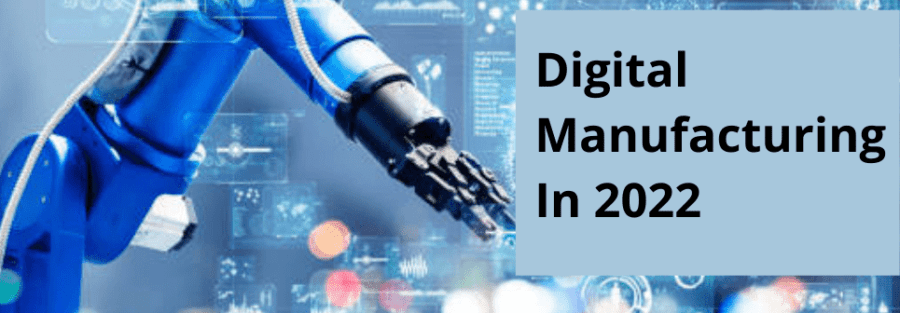Digital manufacturing is the process that is focused on the use of computers. In the manufacturing process when you are using tools and other computer-aided programs (CAP) facilities then you are part of the digital manufacturing club that is going forward at a far quicker pace than the companies that are still dependent on the traditional methods of the manufacturing process.
Through this process, the data about consumers’ purchase habits can be sent to the product managers to plan and manufacture the product that the customer wants. This helps understand the purchasing habits and patterns which will allow the right amount of products to be manufactured without wastage and delay.
What is Digital Manufacturing?
As explained earlier also the digital production uses and incorporates computer-aided programs to construct and simulate, 3-D visualization, analytics, and collaboration to develop products. The manufacturing process includes the layout for manufacturability, computer-incorporated manufacturing, and lean manufacturing. All these processes are specially designed to help the process of digital manufacturing.
It enables the entire process of production including product life cycle, smart factory, and management!
Digital manufacturing is also used for services, supply chains, merchandise, and tactics. It helps to create a hyperlink among the various process of manufacturing one single product starting from the planning phase.
What is the process of digital manufacturing?
This process can be explained in three simple steps: product life cycle, smart factory, and value chain management. We are going to elaborate on all three of them in brief:
The first step, the product life cycle means the entire process of manufacturing the product. This includes the planning and designing phase as well. The engineering layout and sourcing of the right parts and components are also part of the same step. You can also say that it consists of all the plans and initial designs for the product. The product life cycle also includes the information for the revisions that have been made on the design or any other aspect of the original product.
In the second step, the smart factory has all the information about the automation of the factory and the process for manufacturing in the plant. This includes the machinery for the production. The smart factory is the right method to plan the production for the part of the main operations of production in the manufacturing unit.
Value Chain Management especially focuses on the price and distribution of every stakeholder alongside the chain. This is the last and final process that increases the inventories, creates better products. This also helps to achieve higher consumer satisfaction.
What are the advantages of digital manufacturing?
There are some advantages throughout departments at the same time as lowering the chances for errors with the aid of developing an automatic trade of statistics.
Increased performance is achieved with the aid of using a joined-up manufacturing manner which removes mistakes because of misplaced or misinterpreted statistics that are common in traditional manufacturing plants.
With a faster turnaround throughout all tiers, it gives decreased prices, at the same time as taking into account layout adjustments to be applied in actual time and additionally decreasing upkeep prices.
The real-time manufacturing visibility afforded with the aid of using virtual technology offers advanced insights for vital selections and a quicker tempo of innovation.
The digital manufacturing method can also help in creating the right path for the investment process and bringing other stakeholders into the loop for more opportunities in the manufacturing process.
Cloud-based manufacturing opens the record of the resources to evenly distribute load of manufacturing so that one single department does not fall in the category of being overloaded and thereby enhance performance.
Enables product, method, plant, and aid records to be associated, considered, and brought via tactics, with a regular and complete method to manufacturing layout.
It also allows for component manufacturing tactics to be optimized inside controlled surroundings to provide flexible working commands.
It helps in creating a manufacturing facility that is quicker and makes sure they’re working under the most appropriate layout, material, and resources flow.
It enables the plants and manufacturing units to support six-sigma and lean manufacturing by using graphical surroundings.
Application regions of virtual manufacturing
Digital manufacturing has unfolded industries including aerospace and defense. This enables the mixing of delivering networks via cloud computing and collaboration effectively.
Digital manufacturing technology is flawlessly aligned for incorporation into computerized methods including digital component manufacturing, item manufacturing, and milling, and lathing.
The original equipment manufacturer (OEM) can layout the whole manufacturing process digitally. This can include the processes like tooling, machining, assembly, and plant layout. This is done while the designers are creating the next product or are already in the next process for other products. This permits engineers to offer instantaneous remarks to designers if there are constraints in the production. This collaboration among manufacturing engineers and architects creates a holistic view of product and method layout.
The suppliers and traders use digital manufacturing so they can create a better layout of the manufacturing line by using 3D simulation, and examine the distinct manufacturing editions and ideas as a part of the request for quote (RFQ) process. This transparency and precision in making plans and inspiration instruction assist the organization to benefit consumer confidence, and in the end, winning the contract.
Conclusion
Digital manufacturing intends to offer the producing network with answers to create, validate, display, and control agile, allotted manufacturing structures, and build-to-order and lean manufacturing. The scope of digital manufacturing has developed currently to include computer-aided method process planning (CAPP); computer-aided manufacturing engineering (CAPE). This includes the database with all the production statistics, process control statistics, and manufacturing assets.

